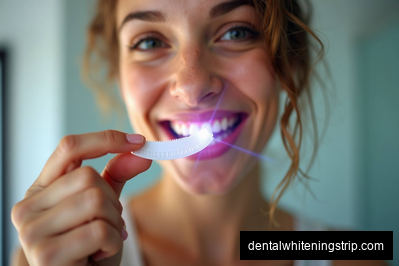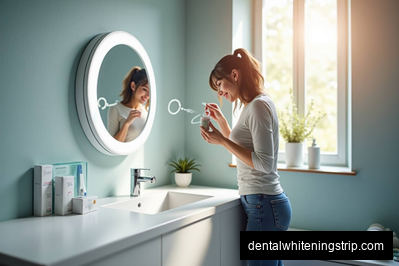Introduction
In the quest for sparking white teeth, dental whitening strips have emerged as a favored home remedy. As per the American Association of Orthodontists, almost 90% of patients request tooth whitening. However, amid the increasing popularity of these products, concerns about their safety have also risen.
This blog post aims to dispel the myths and shed light on the facts about the safety of dental whitening strips. We will delve into the science behind these products, their potential side effects, expert perspectives, and practical recommendations for safe usage.
Building on the introductory discussion of dental whitening strips, it is important to delve into the various types available in the market. From hydrogen peroxide-based strips to carbamide peroxide formulations, the options can be overwhelming for consumers seeking a brighter smile. Understanding the nuances between these types can help users make informed decisions based on their individual needs and preferences.
Furthermore, the effectiveness and duration of results achieved through whitening strips are key considerations. While some strips promise noticeable whitening after just a few applications, others may require more time to deliver desired outcomes. Exploring these differences can aid users in setting realistic expectations and choosing a product that aligns with their goals for teeth whitening. In the realm of dental aesthetics, the journey towards a radiant smile often begins with exploring the intricacies of available whitening strip options.
Understanding Dental Whitening Strips
Dental whitening strips are thin, flexible pieces of plastic coated with a whitening gel. The primary active ingredient in most whitening gels is hydrogen peroxide or carbamide peroxide. The strips are applied to the teeth where they adhere and deliver the whitening agent.
The peroxide in the gel penetrates the tooth enamel, reaching the discolored molecules within. It breaks the bonds holding these molecules together, leading to a lighter tooth color. This process, while effective, has raised questions about the safety of whitening strips.
While dental whitening strips are a convenient way to enhance your smile, it's crucial to understand how they work to achieve optimal results. These strips typically contain hydrogen peroxide or carbamide peroxide as the active whitening agent, which penetrates the enamel to break down stains. Understanding the application process is key; ensure the strip is placed securely on the teeth, covering both the front and back surfaces for even whitening.
Moreover, knowing the duration of wear is essential for avoiding potential side effects like tooth sensitivity. Most whitening strip kits recommend wearing them for about 30 minutes daily over a span of 7-14 days for noticeable results. Remember, consistency is key when using dental whitening strips to maintain a brighter smile. Additionally, it's advisable to consult with your dentist before starting any whitening treatment to address any concerns or determine if whitening strips are the right choice for your dental needs.
Myths and Facts about Dental Whitening Strips
Myth 1: Whitening Strips Weaken Teeth - Fact: Dental whitening strips do not weaken tooth structure. A research study conducted by the Journal of Dentistry found no significant changes in the hardness or mineral content of tooth enamel after using whitening strips. However, they may temporarily soften the enamel, which is why it's recommended to avoid abrasive toothpaste or brushing immediately after use.
Myth 2: Whitening Strips Cause Tooth Sensitivity - Fact: Tooth sensitivity following the use of whitening strips is usually temporary. A study by the Journal of Clinical Dentistry found that only 4% of users reported sensitivity, and it resolved within 96 hours. However, individuals with pre-existing sensitive teeth may experience increased sensitivity.
Myth 2: Whitening Strips Cause Sensitivity - Fact: While some users may experience temporary sensitivity after using dental whitening strips, it is not a permanent issue and usually resolves on its own. In fact, many modern whitening strip formulas contain ingredients like potassium nitrate and fluoride to help combat sensitivity, making them suitable for individuals with sensitive teeth.
Moreover, another common myth is that whitening strips can damage tooth enamel. However, when used as directed, reputable whitening strips are formulated to be enamel-safe. It's essential to follow the instructions provided and not exceed the recommended usage to ensure optimal results without compromising the health of your teeth. Always consult with your dentist before beginning any whitening treatment to address any concerns and ensure you are choosing the best option for your oral health.
Potential Side Effects and Safety Measures
While dental whitening strips are generally safe, they can have potential side effects if used improperly. Misuse can lead to gum irritation, heightened tooth sensitivity, and uneven whitening. It's crucial to follow the manufacturer's instructions and avoid overuse.
Gum irritation can occur if the whitening strip is in contact with the gums for too long. This can be avoided by properly aligning the strips with the gum line. For those with sensitive teeth, a desensitizing toothpaste can be used before and after the whitening treatment. Furthermore, uneven whitening can occur if the strips are not correctly placed or if they move during the treatment.
In addition to the common side effects like tooth sensitivity and gum irritation that can occur with dental whitening strips, there are other less-discussed but equally important safety measures to consider. One such precaution is ensuring that the strips are applied correctly to prevent uneven whitening or damage to the enamel. Proper application involves aligning the strips precisely with the teeth and avoiding contact with the gums to minimize the risk of irritation.
Moreover, it's crucial to follow the recommended usage guidelines provided by the manufacturer to prevent overuse, which can lead to heightened sensitivity or even harm the tooth structure. Understanding the potential side effects and taking proactive safety measures can enhance the whitening experience while safeguarding oral health. Regularly consulting with a dental professional can also provide personalized guidance on using whitening strips safely and effectively.
Expert Perspectives
Dental professionals agree that when used correctly, dental whitening strips are safe. Dr. John D. Burch of Mountain View, CA, states, "Whitening strips are a safe and effective way to remove surface stains and lighten the color of your teeth. However, they should not replace regular dental check-ups and cleanings."
Dr. Martha Ann Keels, a pediatric dentist and division chief at Duke Children's Hospital, advises caution for younger users. "Whitening products should not be used on children under the age of 16. Their enamel is thinner, and the pulp is larger, which can lead to sensitivity and damage."
Expert Perspectives in the field of dentistry can provide invaluable insights into the safety and effectiveness of various dental treatments, such as whitening strips. Professionals like Dr. John D. Burc play a crucial role in educating patients on the proper usage and potential benefits of dental whitening strips. Their expertise helps patients make informed decisions about their oral health and cosmetic treatments.
By seeking out expert opinions and perspectives, individuals can gain a deeper understanding of the science behind dental care products and procedures. These insights can help dispel myths and misconceptions surrounding dental whitening strips, empowering patients to achieve their desired results safely and effectively. Consulting with dental professionals who offer expert perspectives can lead to a more positive and informed approach to oral care, promoting overall oral health and well-being.
Conclusion
In conclusion, dental whitening strips, when used correctly, are a safe and effective method for teeth whitening. They do not weaken the teeth, and any sensitivity caused is typically temporary. However, it's essential to follow the recommended usage instructions and to consult with a dental professional if you have any concerns.
Always remember, dental whitening strips are not a substitute for regular dental check-ups and good oral hygiene practices. As we continue to unveil the myths and facts about dental health, let's strive for a bright, healthy smile safely and responsibly.
As we wrap up our discussion on dental whitening strips, it's crucial to highlight the importance of maintaining regular dental check-ups even after achieving a brighter smile. While these strips can effectively enhance the appearance of your teeth, they do not replace the need for professional dental care. Regular visits to your dentist are essential for monitoring your oral health, addressing any underlying issues, and ensuring that your teeth and gums are in optimal condition.
Furthermore, it's worth noting that the longevity of the whitening effects from these strips can vary depending on individual habits and lifestyle choices. Factors such as smoking, consumption of staining foods and drinks, and oral hygiene practices can impact the duration of the whitening results. Therefore, it's advisable to follow good oral hygiene practices, such as brushing and flossing regularly, to maintain the whiteness of your teeth for a longer period. In conclusion, while dental whitening strips can be a convenient solution for achieving a brighter smile, combining them with proper dental care habits is key to sustaining that radiant smile in the long run.









